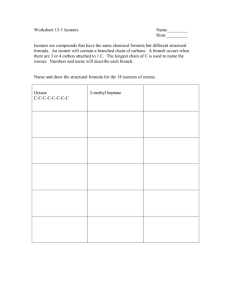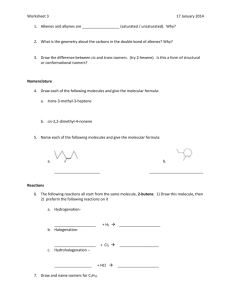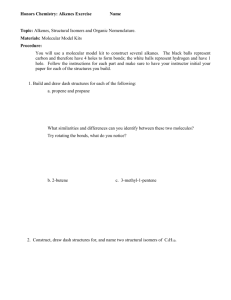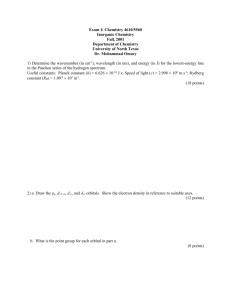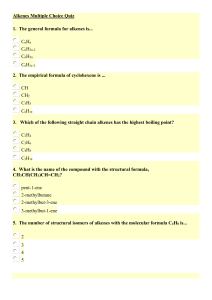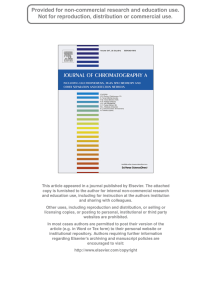Hydrocarbons 4H1 Oct week Homework
advertisement
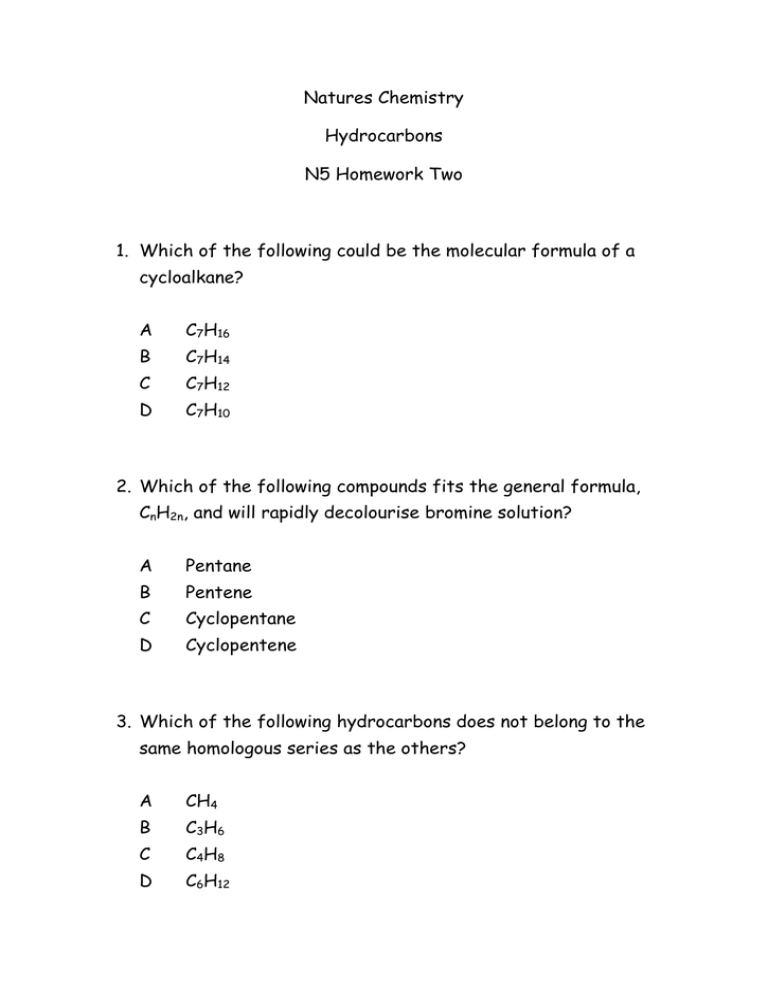
Natures Chemistry Hydrocarbons N5 Homework Two 1. Which of the following could be the molecular formula of a cycloalkane? A C7H16 B C7H14 C C7H12 D C7H10 2. Which of the following compounds fits the general formula, CnH2n, and will rapidly decolourise bromine solution? A Pentane B Pentene C Cyclopentane D Cyclopentene 3. Which of the following hydrocarbons does not belong to the same homologous series as the others? A CH4 B C3H6 C C4H8 D C6H12 4. The first three members of the alkyne homologous series are: What is the general formula for this homologous series? A CnHn B CnHn+1 C CnHn+2 D CnH2n-2 5. Which of the following compounds belongs to the same homologous series as the compound with molecular formula C3H8? 6. Which of the following compounds has an isomer? 7. Two isomers of butene are; Which of the following structures represents a third isomer of butene? 8. Which of the following is an isomer of heptane? 9. Which compound is an isomer of the one shown above? 10. The name of the above compound is A Pent-2-ene B But-2-ene C Pent-3-ene D But-3-ene 11. The name of the above compound is A 1,1 dimethylpropane B 2 ethylpropane C 2 methylbutane D 3 methylbutane 12. Which line in the table correctly identifies the Process X and the Compound Y? 13. The structure of an alkane is shown below. (a) Name this alkane. (b) Draw the shortened structural formula for this alkane. (c) The alkanes are said to be members of a homologous series. What is meant by a homologous series? 14. A student completed an experiment ‘Testing for Unsaturation’. Results from the experiment are shown below. (a) Complete the table. (b) Care had to be taken when using bromine solution. Give a safety precaution other than eye protection, which should be taken when completing this experiment. (c) Draw the structure of hydrocarbon B. (d) Draw a possible branched structure for hydrocarbon A. 15. The diagram shows how paraffin, C12H26, can be cracked. (a) Name the catalyst used in cracking. (b) Explain why the delivery tube must be removed from the bromine solution before heating is stopped. (c) One of the reactions taking place when paraffin is cracked is (i) Identify molecule X. (ii) Describe what would be seen when X is added to bromine solution. (d) One other reaction that is taking place is CH3CH2CHCH2 + Br2 CH3CH2CHBrCH2Br What name is given to this type of chemical reaction? 16. Gases can be liquefied by increasing pressure, but above a certain temperature it is not possible to do this. This temperature is known as the critical temperature. The critical temperatures of the alkanes are shown below’ (a) Describe the trend in critical temperatures for the straight-chained alkanes. (b) Predict the critical temperature of the alkane below. (c) Give the systematic name of this branched alkane. 17. Iodine can react with propene in the following way. (a) Name the homologous series to which propene belongs. (b) Draw the shortened structural formula of propene. (c) Name the type of reaction taking place when iodine reacts with propene. (d) Draw an isomer of propene which is a member of a different homologous series. Natures Chemistry Hydrocarbons N5 Homework Three 1. The key below shows the names and general formula of some families of the hydrocarbons. (a)(i) Butyne is an alkyne with 4 carbon atoms. Using the key, write the molecular formula for butyne. (a)(ii) Hydrocarbon X is a ring compound with molecular formula C6H6. Using the key, name the family to which it belongs. (b) Draw the full structural formula for the octane. (c) Name a chemical test, including results, which shows that an alkene has a carbon to carbon double bond in its structure. 2. Butene has the structural formula shown below. (a) Butene reacts with hydrogen gas. Name the type of reaction taking place when butane reacts with hydrogen gas, H2. (b) Write the molecular formula for the product formed in this reaction. 3. Cracking long-chained hydrocarbons produces smaller, more useful molecules. One of the reactions taking place is: C10H22 C5H12 Decane Pentane + x (a) Draw the structural formula of pentane. (b) Write the molecular formula for X. (c) X decolourises bromine water. What does this tell you about X. (d) Draw a full structural formulae equation that demonstrates the addition of bromine in this reaction. 4. The alkenes and cycloalkanes have the same general formulae. (a) State the general formulae for the alkenes and the cycloalkanes. Than alkene and its equivalent cycloalkane are isomers. (b) State clearly the definition of an isomer. Isomers have different properties. (c) State different uses of alkenes and cycloalkanes. Hexene and cyclohexane are isomers. (d) Draw the full structural formulae of these two isomers. 5. Octane molecular formula C8 H18 has eighteen isomers. Draw and name five different isomers of octane 6. Name the following branched alkanes. (a) (b) (c) (d) 7. Name the following branched alkenes. (a) (b) (c) (d) 8. Draw the following branched alkanes. (a) 2,3-dimethylpentane (b) 2,2,4-trimethylpentane (c) 3-ethyl,2-methylpentane (d) 2,2-dimethylbutane (e) 2-dimethylpropane 9. Draw the following Branched alkenes (a) 2,3-dimethylbut-1-ene (b) 2,2-methylhex-3-ene (c) 3-ethylpent-1-ene (d) 2,4,4-trimethylpent-1-ene 10. (a) Name the following branched cycloalkanes. (b) 11. Draw the following branched cycloalkanes. (a) 1,3-dimethylhexane (b) 3-ethyl,3-methylpentane
